This informal CPD article, ‘Why ISO 35001 certification is vital for laboratories and related organizations’, was provided by Punyam Academy, an industry leader in training of international compliance standards.
Introduction
The handling of biological materials in itself is dangerous. Incidents involving biological hazards can have a significant impact on the safety and health of those who work in laboratory settings. Despite this fact, it is essential for laboratories and related organizations engaged in testing of biological materials such as blood, secretions, tissues of human or animal origin, etc., for diagnosing diseases, pharmaceutical and scientific research, etc.
The growing threats of the malicious use of pathogens and in the recent past, the outbreak of COVID-19 pandemic caused by SARS-CoV-2 or novel corona virus, have drawn attention of the world to the risks of biological materials and the need for stringent, risk-proof ways of handling them. Effective risk management of biohazardous materials reduces chance of such accidents, less impact on the environment and a more efficient use of time and other resources.
A biorisk management system is a key step towards this. In November 2019, International Organization for Standardization (ISO) published a new international management system standard ISO 35001 for biorisk management system, which enables a laboratory or related organizations to effectively identify, control and manage the biosafety or biosecurity risks related to its activities.
What is ISO 35001 Biorisk Management System?
Simply put, it is a management system that fulfills the requirements of ISO 35001:2019. This standard establishes the biorisk management principles that enable laboratories and related facilities to achieve their biosafety and biosecurity objectives. ISO 35001 biorisk management system describes a comprehensive biorisk management process that mitigates biorisks, which includes biosafety and biosecurity risks, and defines the essential elements of a biorisk management system framework to be integrated into a laboratory or other related organization’s overall governance, strategy and planning, management, reporting processes, policies, values, and culture.
Biorisk management is the effective management of risks posed by working with infectious agents and toxins in laboratories and other related organizations. It is a comprehensive approach to assess, control, mitigate and ultimately manage risks associated with biological materials.
The ISO 35001 biorisk management system is based on a management system approach, which enables an organization to effectively identify, assess, control, and evaluate the biosafety and biosecurity risks inherent in its activities. It focuses on mitigating the risks posed by “unintentional" release of a biological agent by the application of pertinent controls. Risks may arise due to accidents or incidents which may occur in the laboratory as a result of a lack of oversight and lack of adherence to standard operating procedures. Here the "intent" is not to cause harm. However, the consequences include a significant impact on the laboratory users as well as the community.














